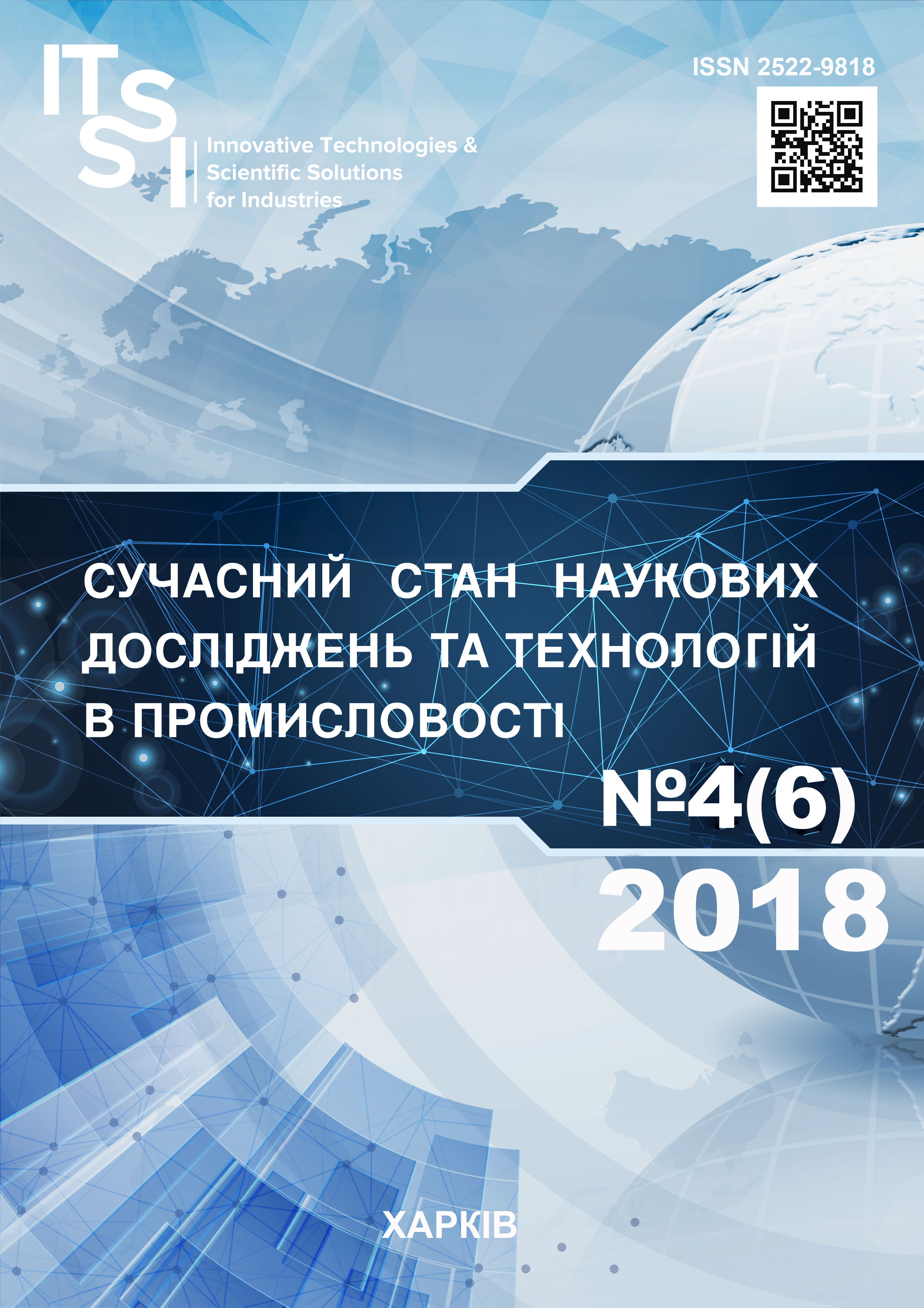ТЕОРЕТИЧНІ ОСНОВИ ОПТИМІЗАЦІЇ ХОЛОСТИХ ПЕРЕМІЩЕНЬ ІНСТРУМЕНТА ПРИ ФРЕЗЕРУВАННІ СКЛАДНИХ ПОВЕРХОНЬ
DOI:
https://doi.org/10.30837/2522-9818.2018.6.062Ключові слова:
ЧПК, інструмент, фрезерування, проектування, складнопрофільна поверхня, чистова обробкаАнотація
Предметом дослідження в статті є вплив послідовності виконання переходів на допоміжний час, що витрачається на холосте переміщення верстата при зміні оброблюваної ділянки і при зміні інструменту. Мета дослідження полягає в підвищенні продуктивності процесу чистового фрезерування при обробці деталей складної форми шляхом мінімізації допоміжного часу, що дозволяє визначити оптимальну послідовність виконання переходів. В статті вирішуються наступні завдання: визначення основних підходів у формуванні загальних стратегій обробки деталей зі складними поверхнями, аналіз алгоритмічних рішень і методів визначення найліпшого маршруту переміщень інструментів від дільниці до дільниці і найвигіднішої послідовності обробки ділянок складної поверхні з урахуванням обмежень по переміщенням і стійкості інструменту, розробка математичної моделі мінімізації холостих переміщень при зміні оброблюваних ділянок і інструментів на основі точкового опису геометрії деталі. Використовуються такі методи: теоретичні та експериментальні методи дослідження, що включають методи системно структурного аналізу; методи математичної статистики; чисельні методи вищої математики, теорія графів. Отримано наступні результати: В результаті комплексних теоретичних і експериментальних досліджень виявлено методи оптимізації приватних і загальних стратегій при обробці деталей зі складними поверхнями. Розроблено метод визначення оптимального маршруту фрез одного типорозміру при русі між групою ділянок, що підлягають обробці. На основі точкового опису геометрії деталі розроблена математична модель мінімізації холостих переміщень при зміні оброблюваних ділянок. Визначено параметри, що забезпечують мінімізацію холостих переміщень при зміні оброблюваних ділянок і реалізацію алгоритмів розрахунку довжини і положень локальних площ безпеки для послідовно оброблюваних ділянок Висновки: Застосування підходів у формуванні загальних стратегій обробки деталей зі складними поверхнями сприяє підвищенню продуктивності і ефективності використання дорогих багатоцільових верстатів. Застосування даного методу визначення найліпшого маршруту переміщень інструментів дозволяє визначити варіант маршруту з мінімальним значенням допоміжного часу, що витрачається на холості рухи інструментів.Посилання
Radzevich, S. P. (2001), Shaping surfaces of parts [Formoobrazovanie poverhnostej detalej], Rastan, 592 p.
Directory technologist-mechanical engineer [Spravochnik tehnologa-mashinostroitelja] / Edited by A. M. Dalsky, Moscow : Engineering-1, 2003, 912 p.
Shikin, E. V., Boreskov, A. V. (2000), Computer graphics. Polygonal models [Komp'juternaja grafika. Poligonal'nye modeli], Moscow : DIALOG-MIFI, 464 p.
Skorkin, А., Kondratyuk, O. (2017), "The basic principles of the integrated management of the process of assembly and threading", Innovative Technologies and Scientific Solutions for Industries, No. 2 (2), P. 77–85. DOI: https://doi.org/10.30837/2522-9818.2017.2.077.
Baranchukova, I. M., Gusev, A. A., Kramarenko, Yu. B. et al. (1999), Designing Automated Engineering Technology: Proc. for machine building. specialist. universities / ed. Yu. M. Solomentsev, 2nd ed. M.: Higher. Sc., 416 p.
Kormen, T. et al. (2005), Algorithms. Construction and analysis / Trans. from English I. V. Krasikova, N. A. Orekhova, V. N. Romashova, 2nd ed., Moscow : Williams, 1290 p.
Baldacci, R., Hadjiconstantinou, E., Mingozzi, A. (2004), "An Exact Algorithm for the Capacitated Vehicle Routing Problem Based on a Two-Commodity Network Flow Formulation", Operations Research, Vol. 52, P. 723–738.
Wallner, J. (2001), "Smoothness and Self-Intersection of General Offset Surfaces", Geometry, Issue 70, P. 176–190.
Archetti, C., Hertz, A., Speranza, M. G. (2006), "A tabu search algorithm for the split delivery vehicle routing problem", Transportation Science, Vol. 40, P. 64–73.
Baldacci, R., Hadjiconstantinou, E., Mingozzi, A. (2004), "An Exact Algorithm for the Capacitated Vehicle Routing Problem Based on a Two-Commodity Network Flow Formulation", Operations Research, Vol. 52, P. 723–738.
Barnhill, R.E., Farin, G., Fayard, L., Hagen, H. (1988), "Twists, Curvatures and Surface Interrogation", Computer Aided Design, Vol. 20, No. 6, P. 341–346.
Beck, J. M., Farouki, R. T., Hinds, J. K. (1986), "Surface Analysis Methods", EEE Computer Graphis and Application, Vol. 6, No. 12, P. 18–36.
Clarke G., Wright, J. W. (1964), "Scheduling of vehicles from a central depot to a number of delivery points", Operations Research, No. 12, P. 568–581.
Cohen, E., Lych, T., Schumaker, L. (1986), "Algorithms for degree raising for splines", ACM Transactions on Graphics, Vol. 4, No. 3, P. 171–181.
Aksen, D., Zyurt, Z., Aras, N. (2006), "Open vehicle routing problem with driver nodes and time deadlines", Journal of the Operational Research Society, Vol. 58, Issue 9, P. 255–261.
Dill, J. C. (1981), "An Application of Color Graphics to the Display of Surface Curvature", SIGGRAPH, P. 153–161.
##submission.downloads##
Опубліковано
Як цитувати
Номер
Розділ
Ліцензія
Авторське право (c) 2018 Антон Олегович Скоркін, Олег Леонідович Кондратюк, Олена Павлівна Старченко

Ця робота ліцензується відповідно до Creative Commons Attribution-NonCommercial-ShareAlike 4.0 International License.
Наше видання використовує положення про авторські права Creative Commons для журналів відкритого доступу.
Автори, які публікуються у цьому журналі, погоджуються з наступними умовами:
Автори залишають за собою право на авторство своєї роботи та передають журналу право першої публікації цієї роботи на умовах ліцензії Creative Commons Attribution-NonCommercial-ShareAlike 4.0 International License (CC BY-NC-SA 4.0), котра дозволяє іншим особам вільно розповсюджувати опубліковану роботу з обов'язковим посиланням на авторів оригінальної роботи та першу публікацію роботи у цьому журналі.
Автори мають право укладати самостійні додаткові угоди щодо не комерційного та не ексклюзивного розповсюдження роботи у тому вигляді, в якому вона була опублікована цим журналом (наприклад, розміщувати роботу в електронному сховищі установи або публікувати у складі монографії), за умови збереження посилання на першу публікацію роботи у цьому журналі.
Політика журналу дозволяє і заохочує розміщення авторами в мережі Інтернет (наприклад, у сховищах установ або на особистих веб-сайтах) рукопису опублікованої роботи, оскільки це сприяє виникненню продуктивної наукової дискусії та позитивно позначається на оперативності та динаміці цитування опублікованої роботи.














